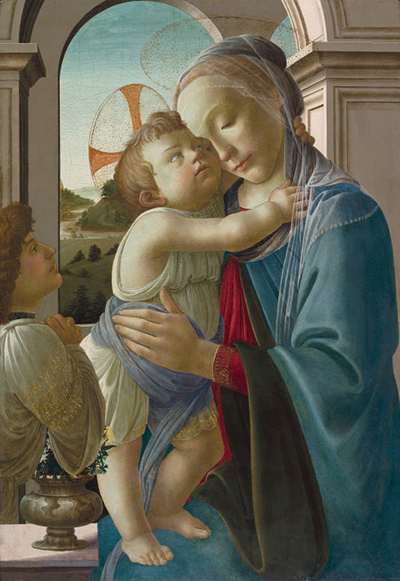Sandro Botticelli would produce many different interpretations of the Virgin Madonna and Child. The artwork in front of us here was known as Virgin and Child with an Angel and there are two different versions in existence.
The composition captures the Virgin and Child in the foreground in a sensitive embrace which is typical of Botticelli's work. He was able to create emotional responses within the viewer in a way that had not been seen before within the Early Renaissance or before that. The child looks lovingly into the eyes of its mother and that is the key focal point, though lots of other detail is added elsewhere within this painting. For example, we can see a young man to the left in side profile who appears to be praying. There is a small bowl in the foreground on a ledge, just behind the Madonna. Behind them all is an architectural archway with a precise use of perspective which leaves an opening through which we can view a green landscape scene with a hill around which a river sweeps past. Botticelli here displays many different genres of work within the same composition, making it an excellent survey of his career, even though the two versions of it are not amongst his most famous paintings.
The version of Virgin and Child with an Angel which exists in the collection of the Art Institute of Chicago is listed as either being from Botticelli's hand, or perhaps instead from one of his many followers. He ran a large studio and so there would be crossover from time to time, and he also regularly collaborated with others in order to complete a larger number of commissions. This artwork is only known about from 1907 onwards, which is why its attribution is hard to determine confidently. An alternative version which is near identical can be found in the Norton Simon Museum in Pasadena. That work can be traced back slightly further to 1877. It must be remembered that Botticelli's own career fell into the shadows until around that point, and so there was less inclination to find some of his missing artworks until the 19th century.
Sandro Botticelli, as mentioned, would produce a large number of paintings of Madonna and Child within his career and found these items to be particularly popular with his patrons and followers. Some other well known examples of this topic from his oeuvre include the likes of Madonna and Child, Madonna of the Magnificat and Madonna della Loggia. He managed to produce a real connection between these two iconic figures and realised from an early point in his career that this format could be re-worked in many different ways in order to explore it as much as possible. He did eventually choose to move into other genres and achieved notable success there too, though some of the qualities of his Madonna depictions could be carried across into those as well.




